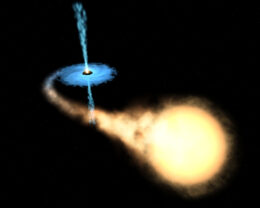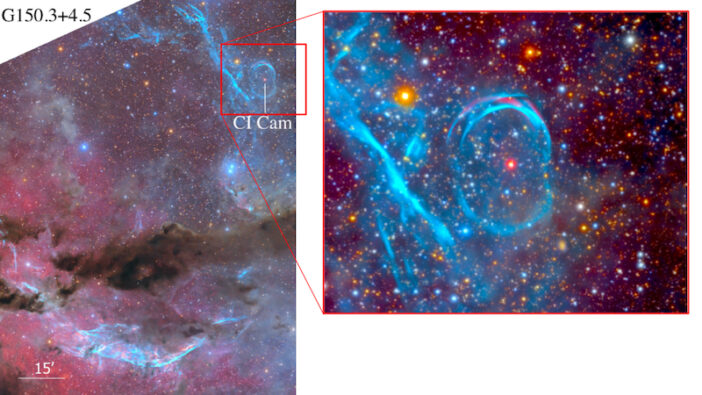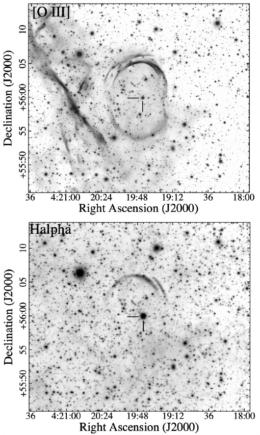Editor’s Note: Astrobites is a graduate-student-run organization that digests astrophysical literature for undergraduate students. As part of the partnership between the AAS and astrobites, we occasionally repost astrobites content here at AAS Nova. We hope you enjoy this post from astrobites; the original can be viewed at astrobites.org.
Title: Discovery of an [O III] Emission Shell Around the X-ray Binary CI Cam
Authors: Robert Fesen et al.
First Author’s Institution: Dartmouth College
Status: Published in RNAAS
From Be Star to X-ray Binary
Among the spectral classes of normal stars that we know and love, there is one particularly eccentric type called the Be stars. Unfortunately, no, the “e” there does not stand for eccentric. Much like the B-type stars, Be stars are incredibly hot and massive objects. However, what sets them apart is the notable presence of excess emission features in their spectral profiles, in contrast with the absorption lines typically seen in the spectra of regular B stars. Thus, the “e” stands for emission.
Our star today, CI Camelopardalis (CI Cam), was initially cataloged as a Be star, but when it was later found that the spectrum was particularly rich in forbidden emission lines, it was reclassified as a B[e]star. The brackets designate the forbidden lines that come from an improbable transition between metastable energy levels in atoms or ions, which can only be observed in low-density astrophysical environments. As an example of this notation, the doubly ionized oxygen forbidden line is written as [O III].

Figure 1: Artist’s illustration of an X-ray binary system that consists of a normal star and a compact object. The gravity of the compact object pulls matter off the normal star creating an accretion disk, shown in blue. [European Space Agency, NASA and Felix Mirabel (the French Atomic Energy Commission & the Institute for Astronomy and Space Physics/Conicet of Argentina)]
The Discovery
In a serendipitous finding, today’s authors uncovered a previously unknown shell of emitting gas surrounding the CI Cam system. This shell, spanning about 8 arcminutes by 12 arcminutes on the sky, is brightest in the forbidden [O III] emission line at 5007 Angstroms (within the optical or visible light regime). The discovery unfolded from the optical data of the large supernova remnant G150.3+4.5 (G150) that was observed as part of a limited wide-field imaging survey of optical emission associated with galactic remnants. This survey was led by Robert Fesen from Dartmouth College (the first author of today’s article). The emission shell was spotted adjacent to the remnant’s filaments along its northwestern edge (see Figure 2).

Figure 2: Composite image showing the emission shell around CI Cam and the western portion of the galactic supernova remnant G150.3+4.5. Blue represents the [O III] emission and red represents the Hα emission. [Adapted from Fesen et al. 2024]

Figure 3: Monochromatic images of the emission shell around CI Cam as seen in [O III] (top) and in Hα (bottom). [Adapted from Fesen et al. 2024]
Due to the similarity in [O III] brightness between the shell and the supernova remnant G150’s filaments, their close proximity raised the question of a potential physical association between the two objects. However, the authors found no direct evidence in the morphology linking the shell to the remnant on the imaging data. They also took into account the available distance estimates for G150 derived from radio and γ-ray observations, which suggested a much closer distance compared to CI Cam. The authors argued that if G150 were actually at CI Cam’s distance, it would have to be a much larger and more ancient supernova remnant, which seems highly unlikely given its bright optical filaments that suggest a relatively young age. The authors then concluded that the apparent proximity of the shell to G150 is likely just a chance alignment with Cl Cam.
While X-ray binaries are primarily studied in the X-ray, optical observations offer a complementary perspective, helping us to understand the details of the binary’s interactions with its surrounding medium. That the size of the emission shell around CI Cam is comparable to those created by powerful Wolf–Rayet stars provides evidence for the strong stellar winds and the transient outburst that CI Cam has unleashed over an extended period. This, in turn, promises to shed light on the mass-loss mechanisms and accretion processes in this class of objects. This discovery not only highlights the significance of wide-field imaging surveys in unveiling previously unknown structures around peculiar objects, but also opens up a new observational window for advancing our understanding of how such systems enrich and shape their cosmic neighborhoods.
Original astrobite edited by Ivey Davis.
About the author, Janette Suherli:
Janette is a PhD student at University of Manitoba in Winnipeg, Canada. Her research focuses on the utilization of integral field spectroscopy for the studies of supernova remnants and their compact objects in the optical. She is also the current chair of Graduate Student Committee for the Canadian Astronomical Society (CASCA). She grew up in Indonesia where it is summer all year round! Before pursuing her PhD in astrophysics, Janette worked as a data analyst for a big Indonesian tech company, combating credit card fraud.
